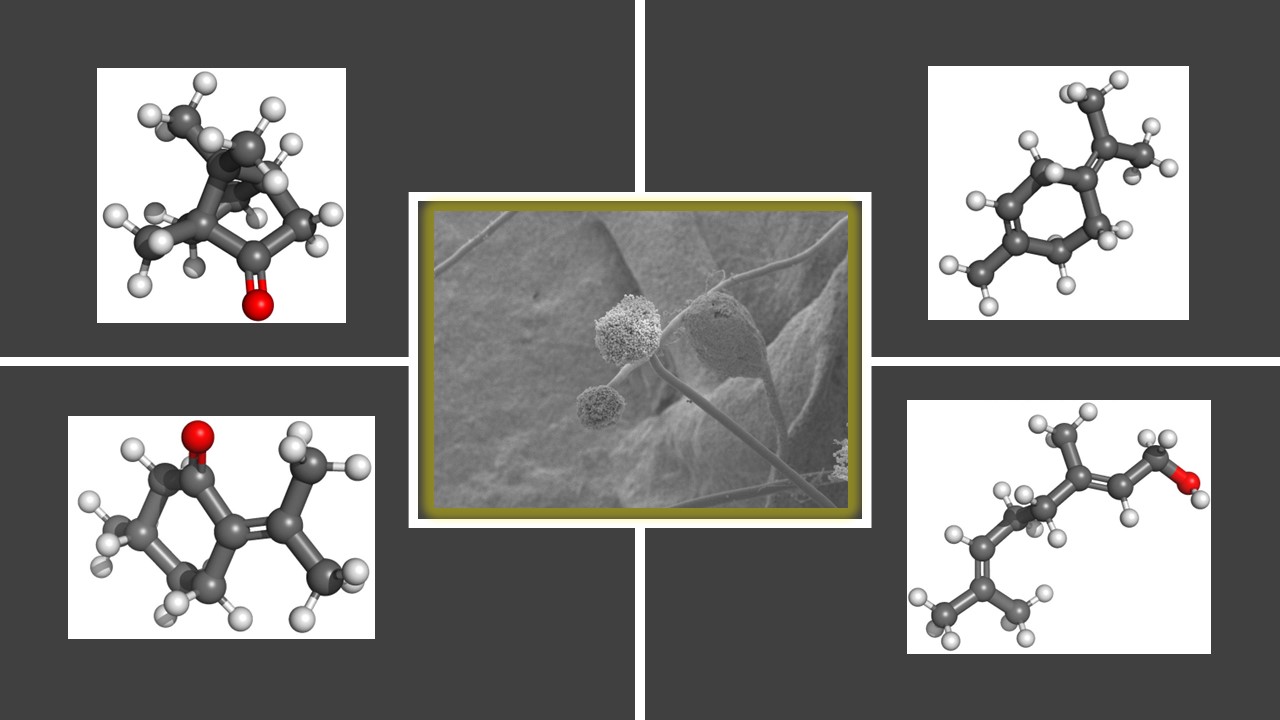Terpenes could be the next weapon in the fight against Aspergillus infections in cannabis. This is especially important information considering that cultivation operations are often plagued by infections of Aspergillus, and now there is the threat of potentially over-reaching regulation looming to curb the problem. Fortunately, the answer to the Aspergillus conundrum might lie within the cannabis plant itself, and particularly in some of its terpene constituents. Breeding cannabis varieties that express high levels of the terpenes and terpenoids discussed below could produce plants that are naturally resistant to Aspergillus species.
The following details are taken from Edition 2 of The Big Book of Terps, which suggests that terpenes including terpinolene, geraniol, pulegone, alpha-cubebene, citronellol, and camphor may offer novel new approaches to resisting or treating Aspergillus infections through genetic engineering and selective breeding, and by the formulation of antifungal products that contain these natural compounds.
As a primary constituent in the essential oil from the leaves of turmeric, terpinolene inhibited growth of the fungus Aspergillus flavus by 100% at just 1.5% concentration[1]. As the primary constituent in the essential oil of Pelargonium graveolens (a type of geranium), geraniol significantly inhibited the growth of the fungi Aspergillus niger, while synergizing the effects of common antifungal drugs[2]. Geraniol has also been shown to inhibit the growth of both Aspergillus flavus and Aspergillus ochraceus by more than 98%[3]. As the primary constituent in the essential oil of ziziphora clinopodioides, pulegone contributed to the inhibition of aflatoxin production in Aspergillus parasiticus as well as inhibition of the growth of the pathogen itself[4]. As a major constituent in the essential oil of Matricaria chamomilla L., alpha-cubebene contributed to potent effects against Aspergillus niger (a type of mold that can sometimes cause disease in humans), causing, among other effects, the disruption of cytoplasmic membranes and intracellular organelles, detachment of plasma membrane from the cell wall, cytoplasm depletion, complete disorganization of hyphal compartments, swelling and deformation of hyphal tips, formation of short branches, and collapse of entire hyphae[5].
The essential oil fraction of P. graveolens and its main components, geraniol and citronellol, exhibited additive effects with amphotericin B and with ketoconazole against both A. flavus and A. niger species. In another study, the essential oil of the leaves of gypsophila bicolor – where terpinolene was a primary constituent – exhibited substantial antifungal activity against Aspergillus niger, penicillium sp., and botrytis cinerea[6]. Camphor oil was shown to inhibit the growth of Aspergillus niger (black mold on vegetables and fruits) by 100%, Aspergillus flavus (rot in grains, nuts, and legumes post-harvest) by more than 96%, and penicillium spp. by nearly 85%[7] when applied topically to certain handicrafts.
Interestingly, bergamotene can be used with around 93% accuracy to detect the presence of invasive fungal infections in the breath of patients suffering from suspected fungal pneumonia caused by Aspergillus fungal species[8], [9]. Other intriguing research has shown that the fungi Aspergillus flavus produces alpha-gurjunene, with scientists finding an apparent correlation between the release of sesquiterpene volatile compounds and the initiation of aflatoxin (a fungal toxin) biosynthesis[10].
Aspergillus is ubiquitous in the environment, and although humans are exposed regularly to spores of this type of fungus, it typically doesn’t cause health problems. However, in some people with compromised or weakened immune systems – particularly some medical cannabis patients – pathogenic infections of the lungs and cardiovascular system can cause serious illness and even death. Consequently, Aspergillus has been targeted by some regulators and lawmakers as an issue requiring strict and prohibitively expensive laboratory testing. Developing cannabis varieties that are naturally resistant to Aspergillus species by engineering and selection for terpene and other phytochemical constituents could be one method of mitigating fungal contamination.
REFERENCES:
[1] Sindhu S, Chempakam B, Leela NK, Suseela Bhai R. Chemoprevention by essential oil of turmeric leaves (Curcuma longa L.) on the growth of Aspergillus flavus and aflatoxin production. Food Chem Toxicol. 2011 May 49(5):1188-92.
[2] Shin, Seungwon. Anti- Aspergillus activities of plant essential oils and their combination effects with ketoconazole or amphotericin b. Archives of Pharmacal Research 26.5 (2003): 389-393.
[3] Xi Tang, Ye-Lin Shao, Ya-Jie Tang, and Wen-Wen Zhou. Antifungal Activity of Essential Oil Compounds (Geraniol and Citral) and Inhibitory Mechanisms on Grain Pathogens (Aspergillus flavus and Aspergillus ochraceus) Molecules. 2018 Sep; 23(9): 2108.
[4] Khosravi AR, Shokri H, Minooeianhaghighi M. Inhibition of aflatoxin production and growth of Aspergillus parasiticus by Cuminum cyminum, Ziziphora clinopodioides, and Nigella sativa essential oils. Foodborne Pathogen Dis. 2011 Dec;8(12):1275-80.
[5] Tolouee, Marziyeh, Soheil Alinezhad, Reza Saberi, Ali Eslamifar, Seyed Javad Zad, Kamkar Jaimand, Jaleh Taeb, Mohammad-Bagher Rezaee, Masanobu Kawachi, Masoomeh Shams-Ghahfarokhi, and Mehdi Razzaghi-Abyaneh. “Effect of Matricaria chamomilla L. flower essential oil on the growth and ultrastructure of Aspergillus niger van Tieghem..” International journal of food microbiology 139.3 (2010): 127-133.
[6] Shafaghat, Ali & Shafaghat Lonbar, Masoud. (2011). Antimicrobial Activity and Chemical Constituents of the Essential Oils from Flower, Leaf and Stem of Gypsophila bicolor from Iran. Natural product communications. 6. 275-6. 10.1177/1934578X1100600230.
[7] Mahilrajan, S., Nandakumar, J., Kailayalingam, R. et al. Screening the antifungal activity of essential oils against decay fungi from palmyrah leaf handicrafts. biol res 47, 35 (2014).
[8] Koo, Sophia, Horatio R. Thomas, S. David Daniels, Robert C. Lynch, Sean M. Fortier, Margaret M. Shea, Preshious Rearden, James C. Comolli, Lindsey R. Baden, and Francisco M. Marty. A Breath Fungal Secondary Metabolite Signature to Diagnose Invasive Aspergillosis. Clinical Infectious Diseases 59.12 (2014): 1733-1740.
[9] Heddergott, C et al. The volatome of Aspergillus fumigatus. Eukaryotic cell vol. 13,8 (2014): 1014-25.
[10] Zeringue HJ, Bhatnagar D, Cleveland TE. C(15)H(24) Volatile Compounds Unique to Aflatoxigenic Strains of Aspergillus flavus. Appl Environ Microbiol. 1993 Jul;59(7):2264-70.
